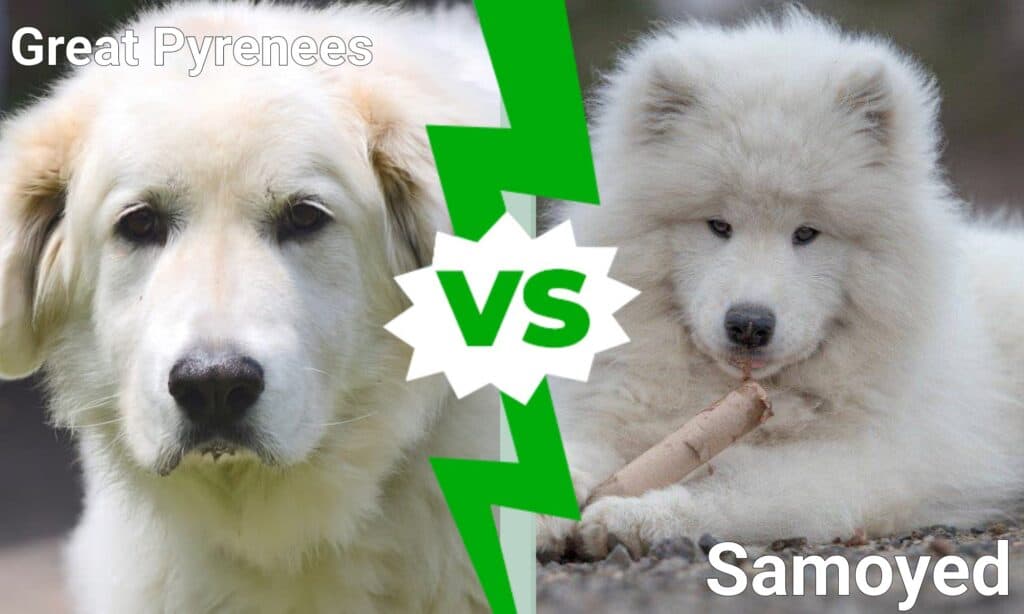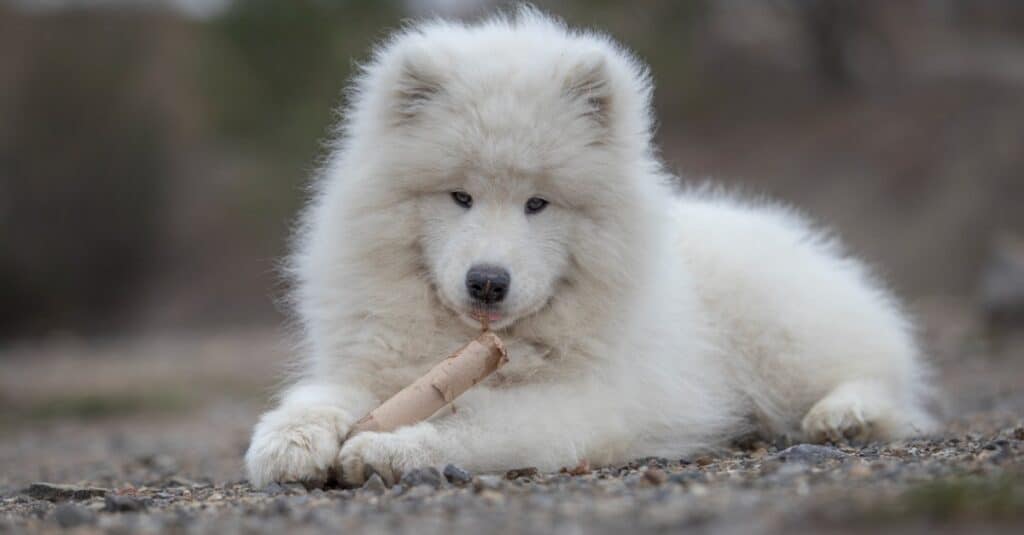From the outside, it may seem like a Samoyed is simply a smaller Great Pyrenees. Despite their sturdy bodies and fuzzy, light-colored coats, however, these dogs have great differences in personality.
Samoyeds like higher grooming needs and a tendency to bark, they tend to be easier first-time dogs that go with the flow and are extreme people-pleasers.
Learn more about these breeds and what sets them apart below.
Comparing Great Pyrenees vs Samoyed

| Great Pyrenees | Samoyed | |
|---|---|---|
| Size | 25-32 inches, 85+ pounds | 19-23.5 inches, 35-65 pounds |
| Appearance | Floppy ears, medium-length double coat | Upright, triangular ears, long double coat, curled tail |
| Coat colors | White | Biscuit, cream, white, white & biscuit |
| Lifespan | 10-12 years | 12-14 years |
| Temperament | May be stand-offish around strangers and children, extremely protective | Friendly, good with children, very protective |
| Trainability | Intermediate | Easy |
| Grooming | Weekly brushing to reduce shed | Daily brushing to prevent mats |
| Drooling Level | Likely to drool | Unlikely to drool |
| Energy | Average | Extremely high with a high need for mental stimulation |
| Noisiness | Moderate barking | Extremely vocal, prone to excessive barking |
10 Key Differences Between Great Pyrenees and Samoyed
The key differences between the Great Pyrenees and Samoyed are their size, appearance, coat colors, lifespan, trainability, grooming needs, drooling level, energy level, and noisiness. The most critical difference however is their temperament.
Let’s discuss all of these in greater detail below so that you know what to expect of these gorgeous pups!
Great Pyrenees vs Samoyed: Size

Great Pyrenees dogs are giant in size, standing up to 32 inches tall.
©everydoghasastory/Shutterstock.com
The Great Pyrenees is a giant breed that stands up to 32 inches tall. Males weigh over 100 pounds, and females weigh over 85 pounds, with no maximum weight according to breed standard. This can make them a challenge to control on-leash and brings up other difficulties as well, such as having to lift them if they’re sick or injured and cannot move by themselves. Of course, larger dogs also cost more to keep fed and vetted.
Samoyeds are quite a bit smaller, standing 19-23.5 inches tall and weighing just 35-65 pounds. They aren’t as suited for work as a guard dog at this size, but they are easier to manage as house pets.
Great Pyrenees vs Samoyed: Appearance
Bred to withstand cold weather, both breeds look quite similar in appearance. However, you will immediately spot a few key differences.
First, Great Pyrenees have floppy ears. Samoyeds’ ears stand naturally upright. Samoyeds also have a tail that curls onto their backs.
Next, less noticeably, a Great Pyrenees will have a medium-length coat that’s shorter than the long fur of a Samoyed.
Great Pyrenees vs Samoyed: Coat Color
Great Pyrenees dogs always have white coats. They might also have tan, gray, badger, or reddish-brown markings.
Samoyeds don’t have these markings, but their coats come in a few (quite similar) colors: biscuit, cream, white, or white and biscuit.
Great Pyrenees vs Samoyed: Lifespan

Samoyeds tend to live longer then Great Pyrenees.
©iStock.com/Abramova_Kseniya
Smaller breeds typically live longer lives, and these two are no exception to the rule. While Great Pyrenees live 10-12 years, Samoyeds live 12-14 years on average.
Great Pyrenees vs Samoyed: Temperament
Here are the differences to watch for in the temperaments of these two breeds:
- Guarding tendencies
- Friendliness toward strangers
- Whether they’re good with children
- Independence
The Great Pyrenees is a livestock guardian. They’re meant to live on farms, surveying the property and making decisions on their own.
Samoyeds were bred as companions, even sleeping with their people to stay warm. They like to be with family and are incredibly people-friendly.
For this reason, Great Pyrenees dogs can be wary of strangers and don’t do well living in the suburbs. They’re independent and can be difficult to train, especially for people without experience.
While these dogs aren’t bad with children, they may not tolerate them as well as a Samoyed. Samoyeds have very high tolerance levels (though children should still be taught to treat them well).
A Samoyed will likely alert you to strangers on the premises, but if an intruder gets in, they’re likely too busy looking for pets to put a stop to their burglary! These dogs tend to think everyone is a friend.
Great Pyrenees vs Samoyed: Trainability

Great Pyrenees dogs can be quite stubborn.
©Ingrid Curry/Shutterstock.com
The Great Pyrenees can be difficult to train due to their independent streak. On a farm, they have to make decisions without human direction. So, if they think they know best, they might not follow your commands.
Training takes a lot of time, consistency, and patience. Lure them into it with a positive attitude and plentiful rewards. Keep training sessions short so that they long for more, and neither of you has time to become frustrated.
Samoyeds, on the other hand, are a breeze to train. These smart, eager-to-please pups will learn quickly. They might struggle most learning how to be alone due to their clingy nature. Be sure to introduce the concept early, keep their associations positive, and avoid leaving them for long periods. This will help to prevent separation anxiety.
Great Pyrenees vs Samoyed: Grooming
Great Pyrenees must be groomed weekly to prevent shed fur from building up in their coat. However, they aren’t overly prone to matting.
Samoyeds are more high-maintenance in the grooming department, requiring a daily brushing to prevent tangles and mats.
Great Pyrenees vs Samoyed: Drooling

A Samoyed will drool less than a Great Pyrenees.
©iStock.com/Roman Bjuty
While Great Pyrenees aren’t the heaviest droolers, they are giant dogs, and that drool will accumulate! You’ll likely be cleaning up often near the water dish and around the dinner table.
Samoyeds don’t drool profusely, though they might salivate like any other dog when they see a yummy treat.
Great Pyrenees vs Samoyed: Energy Level
Samoyeds are energetic, intelligent, and need a lot of physical and intellectual stimulation to stay healthy. They enjoy at least one long walk daily as well as playtime in a well-enclosed area.
Great Pyrenees dogs are less energetic. They prefer to spend their day patrolling their property, often on the move but not exerting much energy. This conserves energy so that they can act to protect livestock or family when needed. For added exercise, they enjoy long walks or playtime with family.
Great Pyrenees vs Samoyed: Barking Tendency
Samoyeds are incredibly vocal dogs. They’ll be sure to tell you what they think and are prone to problem barking behaviors. If your Samoyed isn’t well-trained or doesn’t get enough exercise, they might greatly annoy your neighbors.
The Great Pyrenees is less prone to this behavior, though they can still bark loudly and sometimes excessively. Again, this is most likely to happen due to inadequate exercise or lack of mental stimulation.
The photo featured at the top of this post is © iStock.com/photobac
Ready to discover the top 10 cutest dog breeds in the entire world?
How about the fastest dogs, the largest dogs and those that are -- quite frankly -- just the kindest dogs on the planet? Each day, AZ Animals sends out lists just like this to our thousands of email subscribers. And the best part? It's FREE. Join today by entering your email below.
Thank you for reading! Have some feedback for us? Contact the AZ Animals editorial team.






